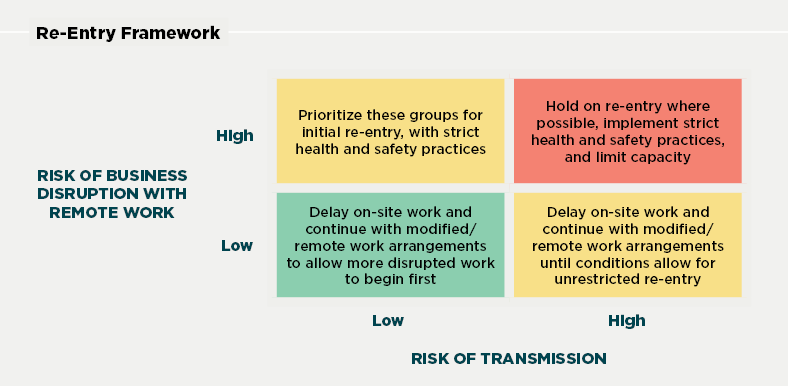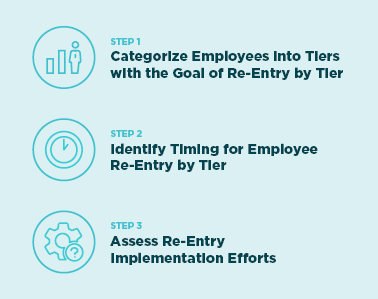
Author:
Catherine Carter, Manager (Email)
With many states, counties, and municipalities announcing plans to lift or phase out stay-at-home orders and other restrictions, figuring out what “back to normal” looks like from a practical standpoint seems fraught with difficulty.
While local government organizations have always played a role in promoting and ensuring public health and safety, and many have dedicated emergency management and business continuity groups, individual managers may be less equipped to assess the impacts and risks of a group’s “normal activities” so directly for both their employees and the communities they serve. Plus, post-pandemic re-entry planning will vary at the individual, work group, department, and organizational level. There isn’t a one-size-fits-all approach. So, what factors do managers need to consider?

Risk of Transmission
Re-entry transmission risk is dependent on both human and physical factors, including:
- The number of people who work in a given area
- The workplace layout and employees’ ability to practice social distancing effectively in the workplace
- The extent to which face-to-face interaction with other work groups and/or the public is necessary
- Whether shifts can be staggered to limit the number of people on-site at a given point
- Whether an employee is considered at risk
Risk of Business Disruption
Most parts of the United States have now had four to six weeks to evaluate and fine-tune modified and remote work arrangements. Moving forward, the question shifts to whether the individual, work group, department, or organization can fulfill its mission and continue to serve its community while continuing operations under modified arrangements. Take the time to consider:
- Critical work tasks that can only be completed in the workplace
- Primary process-oriented tasks that are best completed in the workplace
- Tasks or processes that require several individuals or groups to participate
- Any work that can be completed independently and does not require face-to-face interactions
The following framework may help with developing a customized plan for re-entry.

Strict health and safety practices might include mandating the use of protective coverings/masks for all on-site personnel, requiring certain personal hygiene practices (e.g., frequent handwashing, coughing and sneezing etiquette, use of hand sanitizer/disinfectant), mandating temperature checks, and/or increasing the amount of sick leave available for employees. Many organizations are also considering physical changes to the office or worksite, such as creating plexiglass or solid screens, reconfiguring the space to allow more distance between workstations, and limiting the number of people who can use certain equipment.

Steps to Develop a Re-Entry Plan
Most organizations are not planning to bring all employees back to work at the same time to minimize the risk of transmission and reduce contribution to a second wave of COVID-19 infections. The following are steps to help phase the re-entry approach:

Step 1: Categorize Employees into Tiers with the Goal of Re-Entry by Tier
- Determine whether employees are essential or non-essential (by geographic location, role, etc.), are required to work on-site or can work remotely, and are considered at risk
- Make reasonable accommodations, keeping in mind employee well-being and state of mind, etc.
- Ensure similar treatment of managers, supervisors, and front-line employees, which may include a rotation of the leadership team to ensure business continuity
Step 2: Identify Timing for Employee Re-Entry by Tier
- Comply with jurisdiction-specific requirements
- Review guidance from medical experts (e.g., the CDC and state/local public health officials)
- Consider organizational needs and community demand (once stay-at-home orders lift)
- Look at what peer organizations are doing or emerging best practices
Step 3: Assess Re-Entry Implementation Efforts
- Document new processes, risk mitigation strategies, or lessons learned to build into future business or operational continuity plans
- Reassess organizational strategies, mission, and desired outcome areas to determine whether there are areas that need to be reprioritized or updated to better address the new landscape
- Assess major operational and business process changes that were instituted during the stay-at-home timeframe and decide whether to maintain these practices moving forward (e.g., determine if utilities should continue to promote transitioning customers to an online bill payment)

Sample Re-Entry Plan
The City of Roswell, GA has developed a three-phased approach to re-entry, which illustrates how this process can be applied. Each department within the City of Roswell has an individualized plan, with each phase tailored to that specific department’s work activities and risks. The City’s expected outcomes include supporting established phase re-entry efforts for a safe workplace, supporting established “new normal” efforts post-COVID-19 as an effort to safeguard the public and workforce, and continuing to review and implement established safety practices that will impact the City and its ability to provide services.
Phase I
- Continue to encourage telework wherever possible and feasible based on business operations. If possible, return to work in phases
- Close common areas where personnel are likely to congregate and interact or enforce strict social distancing protocols
- Minimize non-essential travel and adhere to CDC guidelines regarding isolation following travel
Strongly consider special accommodations for personnel who are members of a vulnerable population
Phase II
- Continue to encourage telework whenever possible and feasible based on business operations
- Close common areas where personnel are likely to congregate and interact or enforce moderate social distancing protocols
- Non-essential travel may resume
- Strongly consider special accommodations for personnel who are members of a vulnerable population
Phase III
- Resume unrestricted staffing of worksites
Additional Resources





